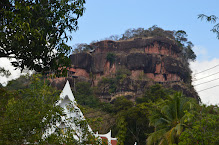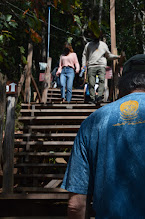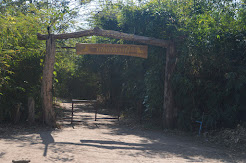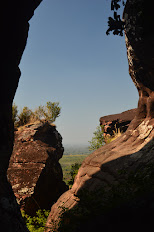If you saw a flat topped hill rising out of flat land, what would you decide to do?
Is this a trick question, Spike?
Not at all! This is serious.
I would probably just keep going? Why, what would you do?
I don't know, either, Captain. But I probably would not think to make temples on the sides and carve and build path ways around it to get to the top.
Like Ajarn Juan did?
Exactly!
Wat Phu Tok, is on a 359 meter isolated hill in Bueng Kan Province. Phu Tok actually means "lonely mountain."
And Ajarn Juan, a Buddhist monk, decided to dedicate it to hikers meditating on the seven levels of Buddhism as they climb ladders, cross wooden walkways, and walk through tree lined areas as they go up.
If you choose to make the climb, we will pass on the advice we were given: stay left! The left path stays in the shade, has wide ladders and paths, and is a lot easier going up. The right path? It uses the wooden paths that cling to the sides of the cliffs and has steeper ascents.
Signs are all in Thai, so it's difficult to know which level you are at if you don't know the Thai numerals. However, when the path ends, you know you are at the top! Do be on the lookout for snakes on the last part of the ascent.
One thing to be sure to do is bring plenty of water! Especially if you try the cliff path. That one is all in the sun!





















































